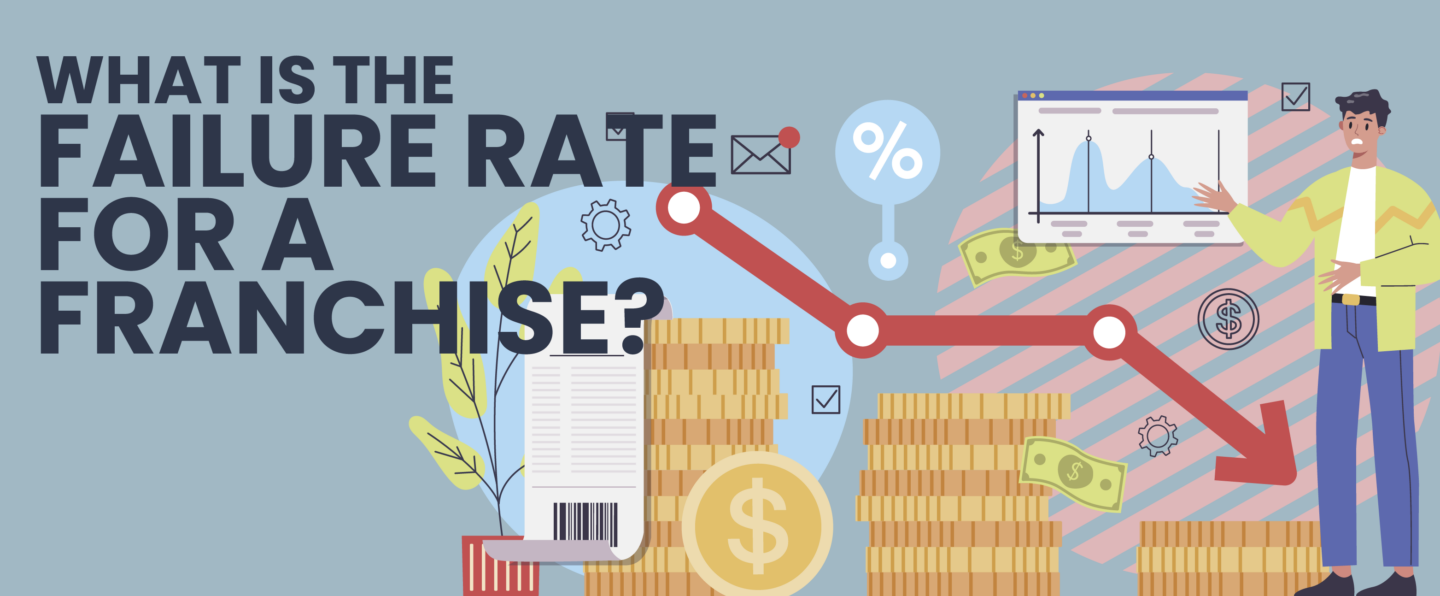
What Is the Failure Rate for a Franchise? Breaking Down Risk Factors
Buying a franchise can be an exciting prospect, but there’s no denying that failure has to be taken into account.
So, what’s the failure rate for a franchise? Here’s what you need to know in order to make sure your venture is as profitable as possible — so take note and keep these important considerations top of mind!
Quick Takeaways
- A statistic from a 1987 IFA study claimed franchises have a 5% failure rate, but this was later proven to be inaccurate. Although the IFA retracted the statement in 2005, it is still quoted today.
- There are three main factors that contribute to franchise failure: mismatched goals, lack of proper funding, and failure to adapt to business trends.
- One example of a failed franchise business is Blockbuster, which filed for bankruptcy in 2010. The main reasons for its downfall were its inability to evolve fast enough, lack of funding, and mismatched goals within the company.
- KFC is an example of a profitable franchise with a current valuation of $5.4 billion. Its success can be attributed to product innovation and unified goals among all franchisees.
What Is the Failure Rate for a Franchise?
A widely publicized statistic from a 1987 International Franchise Association (IFA) study showed that franchises have a failure rate of 5% (which would equate to an unbelievable success rate of 95%).
In comparison, the U.S. Bureau of Labor Statistics (BLS) states that 20% of new small businesses fail during the first two years, 45% in the first five years, and 65% in 10 years.
So if you saw that 5% failure rate over the years and were skeptical, it was for a good reason.
In 2005, the IFA later sent a formal letter asking franchisors to stop using that statistic because it was not accurate.
Yet, some franchisors, brokers, and consultants in the industry continue to use it today in attempts to claim that owning a franchise has a higher success rate than independent businesses. This inaccurate statistic is now known as “The Stat” online.
Whether you have your own independent business or a franchise, you will be at risk of failure. That’s simply the hard truth of business ownership.
While franchise businesses have many benefits, including the advantage of a proven business model and an established reputation, there are pros and cons to both options.
Franchise Success Is Nuanced
While there was another study on franchise success rates done in 1994 by Timothy Bates, professor emeritus at Wayne State University, it doesn’t reflect today’s economy.
Bates looked at more than 20,500 small businesses and found that 65.3% of franchises survived after four years compared to 72% of independent businesses. Retail franchises had a lower survival rate of 61.3% compared to 73.1% of independent retail locations.
Unfortunately, there aren’t any recent studies on the failure rates of new franchises due to the overwhelming amount of research needed to provide an accurate number.
It’s estimated that you’d have to look at over 3,000 companies in 80 industries and then weigh results between new and established franchise locations in order to get an accurate picture.
To get the real truth about franchising, we’ll need to understand what causes franchise failure and look into a few cases.
What Causes Franchises to Fail?

When a franchise doesn’t meet its business goals, we can say it has failed. This can be due to poor management by the franchisors or franchisees.
However, other factors contribute to the franchise failure rate. Here are three of them.
Mismatched Goals
The parties in a franchise system, including the franchisor and franchisee, might have different expectations of the company.
For instance, franchisors might have high standards that they expect to be met at each location. However, an inexperienced franchisee might only focus on growth without knowing how to maintain those standards.
This conflict in understanding can lead to problems and, ultimately, cause financial failure.
Lack of Proper Funding
A franchise needs proper funding. This is because a growing business can spend the first few years in a deficit. In this case, adequate funding covers it.
Some people may go into franchising feeling like they need only their capital, then get in and discover they’ll need to sustain the business for the first few years. This risky mindset can also cause franchise failure.
Failing to Embrace Change
Any business can suffer ill health if they don’t evolve. Most franchised businesses that survived the test of time had to evolve to fit the new industry’s needs.
Take McDonald’s as an example. Since its inception, it has continuously adapted to industry demands and world changes — in branding, marketing, menu, customer service, product delivery, partnerships, and more.
This has kept it running for decades and earned it a top spot on the list of successful franchise businesses. They keep their fans happy and coming back for more, which is key for profitability.
Failed Franchise Case Study: Blockbuster
What lessons can we learn from failure? While we don’t have accurate statistics or franchise failure rates to go off of, we can look to real-life examples for answers.
This includes one of the biggest franchise failures in history: Blockbuster.
In the early 90s, Blockbuster charged between $2 to $10 for movie rentals. However, it filed for bankruptcy in 2010, causing it to reduce rentals to 99 cents.
What really happened? The Blockbuster franchise failure was due to three reasons.
- Failure to evolve fast enough: Blockbuster was too late to capitalize on the digital revolution and pivot its model to keep up with the times. Franchisees were more interested in sticking to their old operations — making money off late DVD return fees.
- Not enough funding: Blockbuster owed over a million dollars after finally digitizing its model. However, it lost about $2 every time a customer exchanged a DVD in its store.
- Mismatched goals: Key members of the chain were scared of investing in a sector that was still new (digital movie rentals).
Successful Franchise Case Study: KFC
Kentucky Fried Chicken (KFC) is an example of a franchise business with a high success rate. With its $5.4 billion valuation, it currently stands as one of the top franchises on the IFA’s list.
But how has KFC had such finger-lickin’ good success with franchising? Here are the top three reasons:
- Proper branding: All franchisees maintain the brand style and standards as established by the franchisor.
- Unified goal: All KFC franchisees work to ensure that they deliver Kentucky Fried Chicken using the original recipe, regardless of price changes.
- Product innovation: From targeting millennials with plant-based offerings to partnerships with popular companies like Grubhub, KFC isn’t afraid to adapt to a changing market — and it has paid off.
Factors Affecting Success Rates of Franchises
While we’ve discussed some of the factors that cause franchising failure, here are three that can determine the success rate.
- Brand visibility: A business can take over five to six years to attain good brand visibility. This means they have an existing client base, which is essential for sales and profitability.
- Market position: What are your customers’ needs? If a franchise understands pain points, it can align its goals to solve them. This positions them as a first choice and boosts profitability, which leads to franchise success.
- Workforce: If you have your own business, you must keep a high satisfaction rate. If you’re a franchisor or franchisee, this is possible through quality staff and high-quality products/services. If the workforce has the necessary skills, there are higher chances of franchise success rates. Franchisors can organize training programs to help strengthen the workforce.
Determine What’s Right for You
Franchising can be a smart move for many — but all the data and statistics in the world can’t make you profitable.
Whether you become a franchisor or start a new business, both have their ups and downs. Learning about what contributes to failure rates in franchising can help you make an informed decision about what’s best for you.
Embracing changing consumer needs, product innovation, and having enough capital can help both independent small businesses and franchises greatly improve their chance of success.
